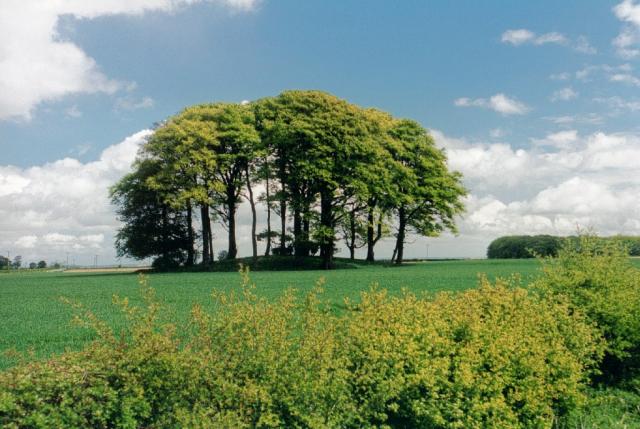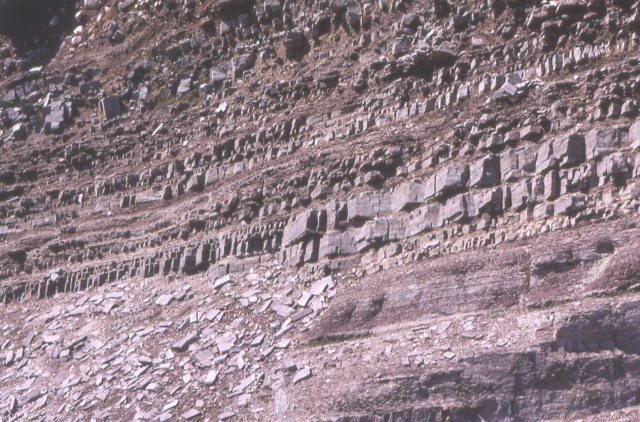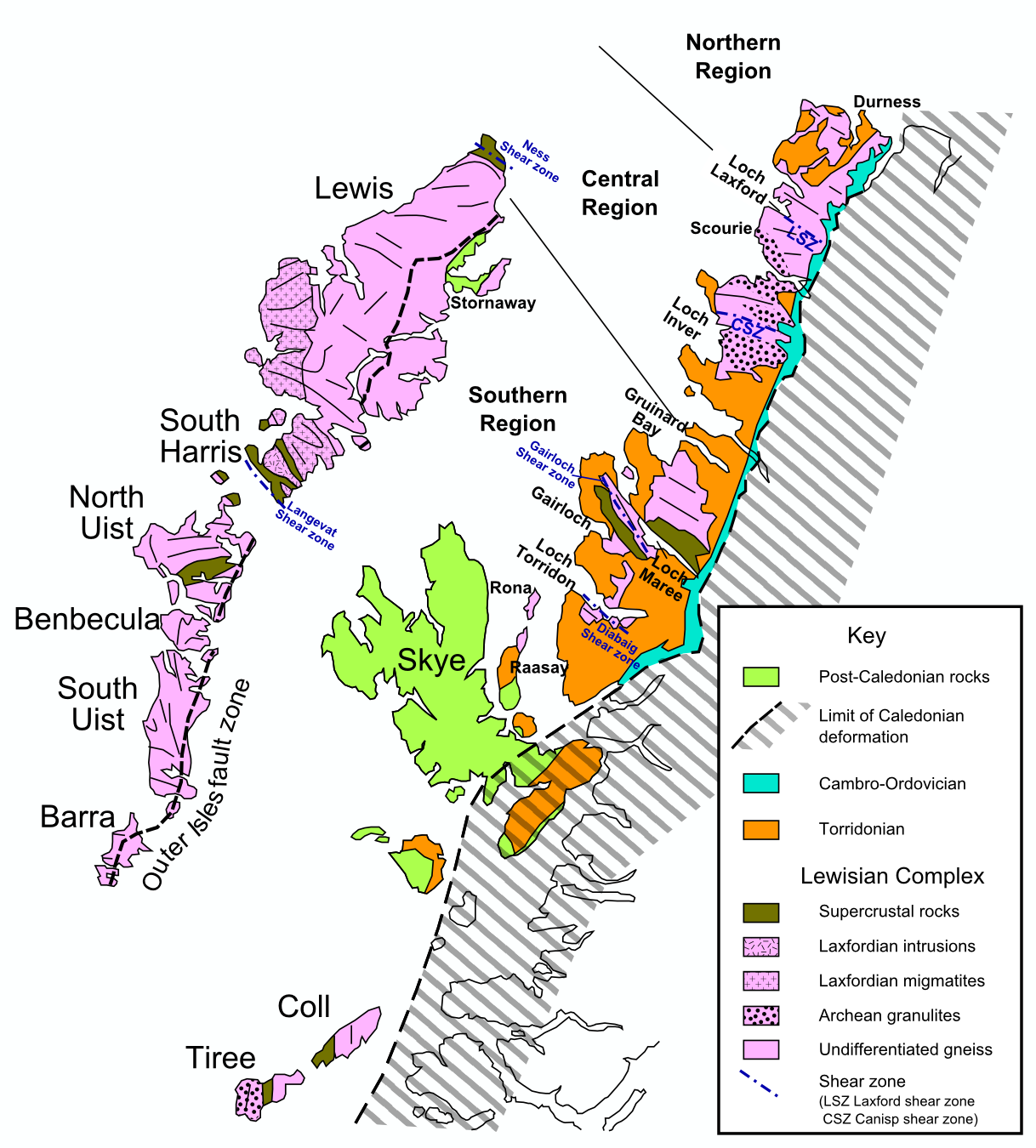|
Arkle (hill)
Arkle () is a mountain in Sutherland, in the far north-west corner of the Scottish Highlands. Like its sister Foinaven, the mountain is made up of glistening white Cambrian quartzite, laid down around 530 million years ago on an uneven basement of much older Lewisian complex, Lewisian gneiss. The quartzite, and the Torridonian sandstone which makes up many of the other mountains in the area, have been dissected by rivers and glaciers, leaving a series of isolated peaks, such as Suilven, Quinag and Stac Pollaidh, standing above the "knock and lochan" landscape of small hills and lakes that is typical of the Lewisian gneiss. 'Ben Arkle' was the subject of a painting by Charles, Prince of Wales. This painting was reproduced by the British Post Office as one of a set of five stamps (SG 1810–1814, issued 1 March 1994) showing paintings by Prince Charles and also, as a commemorative label, in a stamp book (SG HB16) issued 14 November 1994 to celebrate the Prince's 50th birthday. Ar ... [...More Info...] [...Related Items...] OR: [Wikipedia] [Google] [Baidu] |
Loch Stack
Loch Stack is a large, irregularly shaped freshwater loch in the Northwest of Scotland. It lies approximately southeast of Laxford Bridge and is surrounded by mountains. Ben Stack rises steeply from the loch's southwestern shore and Arkle (Sutherland), Arkle lies directly to the north. The outflow from Loch More, which is about south of Loch Stack, is carried (via Loch nan Ealachan) by the small river An Earachd into Loch Stack. Survey The loch was surveyed between 6 and 8 September 1902 by T.N. Johnston and James Murray and later charted as part of the John Murray (oceanographer), Sir John Murray's ''Bathymetrical Survey of Fresh-Water Lochs of Scotland 1897-1909''. References Landforms of Sutherland, Stack Freshwater lochs of Scotland, Stack {{Sutherland-geo-stub ... [...More Info...] [...Related Items...] OR: [Wikipedia] [Google] [Baidu] |
Cambrian
The Cambrian ( ) is the first geological period of the Paleozoic Era, and the Phanerozoic Eon. The Cambrian lasted 51.95 million years from the end of the preceding Ediacaran period 538.8 Ma (million years ago) to the beginning of the Ordovician Period 486.85 Ma. Most of the continents lay in the southern hemisphere surrounded by the vast Panthalassa Ocean. The assembly of Gondwana during the Ediacaran and early Cambrian led to the development of new convergent plate boundaries and continental-margin arc magmatism along its margins that helped drive up global temperatures. Laurentia lay across the equator, separated from Gondwana by the opening Iapetus Ocean. The Cambrian marked a profound change in life on Earth; prior to the Period, the majority of living organisms were small, unicellular and poorly preserved. Complex, multicellular organisms gradually became more common during the Ediacaran, but it was not until the Cambrian that fossil diversity seems to rapidly ... [...More Info...] [...Related Items...] OR: [Wikipedia] [Google] [Baidu] |
Marilyns Of Scotland
This is a list of Marilyn hills and mountains in the United Kingdom, Ireland and surrounding islands and sea stacks. Marilyns are defined as peaks with a prominence of or more, regardless of height or any other merit (e.g. topographic isolation, as used in Munros). Thus, Marilyns can be mountains, with a height above , or relatively small hills. there were 2,010 recorded Marilyns. Definition The Marilyn classification was created by Alan Dawson in his 1992 book ''The Relative Hills of Britain''. The name Marilyn was coined by Dawson as a punning contrast to the ''Munro'' classification of Scottish mountains above , but which has no explicit prominence threshold, being homophonous with (Marilyn) '' Monroe''. The list of Marilyns was extended to Ireland by Clem Clements. Marilyn was the first of several subsequent British Isles classifications that rely solely on prominence, including the P600s, the HuMPs, and the TuMPs. Topographic prominence is more difficult to es ... [...More Info...] [...Related Items...] OR: [Wikipedia] [Google] [Baidu] |
Thoroughbred
The Thoroughbred is a list of horse breeds, horse breed developed for Thoroughbred racing, horse racing. Although the word ''thoroughbred'' is sometimes used to refer to any breed of purebred horse, it technically refers only to the Thoroughbred breed. Thoroughbreds are considered "Hot-blooded horse, hot-blooded" horses that are known for their agility, speed, and spirit. The Thoroughbred, as it is known today, was developed in 17th- and 18th-century England, when native mares were Crossbreed, crossbred with imported stallion (horse), stallions of Arabian horse, Arabian, Barb horse, Barb, and Turkoman horse, Turkoman breeding. All modern Thoroughbreds can trace their pedigrees to three stallions originally imported into England in the 17th and 18th centuries, and to a larger number of foundation bloodstock, foundation mares of mostly English breeding. During the 18th and 19th centuries, the Thoroughbred breed spread throughout the world; they were imported into North America ... [...More Info...] [...Related Items...] OR: [Wikipedia] [Google] [Baidu] |
Arkle
Arkle (19 April 1957 – 31 May 1970) was an Irish-bred Thoroughbred racehorse. A bay gelding by Archive out of Bright Cherry, Arkle was the grandson of the unbeaten Flat racehorse and prepotent sire Nearco. Arkle was bred by Mary Baker of Malahow House, near Naul, County Dublin, and was born at Ballymacoll Stud, County Meath. He was owned by Anne Grosvenor, Duchess of Westminster, who named him after the mountain Arkle in Sutherland, Scotland, which bordered her Sutherland estate. Trained by Tom Dreaper at Greenogue, Kilsallaghan, in County Dublin, Arkle was ridden during his steeplechasing career by Pat Taaffe. Arkle won three Cheltenham Gold Cups and a number of other top races before his career was cut short by injury. At 212, his Timeform rating is the highest ever awarded to a steeplechaser. Early life Arkle, a bay colt with no white markings, was bred by Mary Baker, who kept a few mares on the family farm at Malahow, near Naul in County Dublin. His dam was Bright Che ... [...More Info...] [...Related Items...] OR: [Wikipedia] [Google] [Baidu] |
Stac Pollaidh
Stac Pollaidh () is a mountain in the Northwest Highlands of Scotland. The peak displays a rocky crest of Torridonian sandstone, with many pinnacles and steep gully, gullies. The ridge was exposed to weathering as a nunatak above the ice sheet during the last Ice age, Ice Age, while the ice flow carved and scoured the smooth sides of the mountain. The modern Gaelic name is a recent invention. The peak is named on the first edition Ordnance Survey maps simply as "An Stac" (the pinnacle) and on later maps as "Stac Polly". The "Polly" element is of Norse origin, derived from "Pollå" meaning "pool river". Due to its relatively low height of just over , fine views and ease of access from a road it has become a very popular peak to climb. It also provides some fine scrambling in the traverse of the summit ridge, including one ''bad step'' near the final summit. Consequentially it has suffered from a great deal of erosion, leading to Scottish Natural Heritage constructing a large Tra ... [...More Info...] [...Related Items...] OR: [Wikipedia] [Google] [Baidu] |
Quinag
Quinag () is an 808 m high mountain range in Sutherland in the Scottish Highlands, with an undulating series of peaks along its Y-shaped crest. The name Quinag is an anglicisation of the Gaelic name ''Cuinneag'', a milk pail, reflecting its distinctive shape. Geologically, Quinag is made of Torridonian sandstone, resting on a substrate of Lewisian gneiss. The highest peaks are capped by a thin skin of Cambrian quartzites with the gentle eastern slope of Spidean Coinich being a dip slope formed along the quartzite beds. The massif is an excellent place to appreciate the relationship between these three major rock units of the NW Highland. Ascent Quinag boasts three separate Corbett summits – Sàil Ghorm (Blue Heel ; ), Sàil Gharbh (Rough Heel ; ) and Spidean Coinich (Mossy Peak ; ). From the north and from the road crossing the Kylesku Bridge, Quinag presents a formidable sight with its two huge buttresses of Sàil Gharbh and Sàil Ghorm dominating the skyline. It provi ... [...More Info...] [...Related Items...] OR: [Wikipedia] [Google] [Baidu] |
Torridonian Sandstone
The Torridon Group is a series of Tonian (lower Neoproterozoic) arenaceous and argillaceous sedimentary rocks, which occur extensively in the Northwest Highlands of Scotland. These strata are particularly well exposed in the district of upper Loch Torridon, a circumstance which suggested the name Torridon Sandstone, first applied to these rocks by James Nicol (geologist), James Nicol. Stratigraphy, Stratigraphically, they lie Unconformity, unconformably on gneisses of the Lewisian complex and sandstones of the lithologically similar Mesoproterozoic Stoer Group and their outcrop extent is restricted to the Hebridean terrane. Lithology The dominant lithology of the Torridon Group is red and brown sandstone, often arkose, arkosic, with subsidiary amounts of shale, particularly towards the top of the sequence, with coarse Conglomerate (geology), conglomerates and breccias locally at the base. Some of the materials of these rocks were derived from the underlying Lewisian complex, Le ... [...More Info...] [...Related Items...] OR: [Wikipedia] [Google] [Baidu] |
Lewisian Complex
The Lewisian complex or Lewisian gneiss is a suite of Precambrian metamorphic rocks that outcrop in the northwestern part of Scotland, forming part of the Hebridean terrane and the North Atlantic craton, North Atlantic Craton. These rocks are of Archean, Archaean and Paleoproterozoic age, ranging from 3.0–1.7 billion years (Year#SI prefix multipliers, Ga). They form the Basement (geology), basement on which the Stoer Group, Wester Ross Supergroup and probably the Loch Ness Supergroup sediments were deposited. The Lewisian consists mainly of Granite, granitic gneisses with a minor amount of supracrustal rocks. Rocks of the Lewisian complex were caught up in the Caledonian orogeny, appearing in the hanging walls of many of the thrust faults formed during the late stages of this tectonic event. Distribution The main outcrops of the Lewisian complex are on the islands of the Outer Hebrides, including Isle of Lewis, Lewis, from which the complex takes its name. It is also exp ... [...More Info...] [...Related Items...] OR: [Wikipedia] [Google] [Baidu] |
Quartzite
Quartzite is a hard, non- foliated metamorphic rock that was originally pure quartz sandstone.Essentials of Geology, 3rd Edition, Stephen Marshak, p 182 Sandstone is converted into quartzite through heating and pressure usually related to tectonic compression within orogenic belts, and hence quartzite is a metasandstone. Pure quartzite is usually white to grey, though quartzites often occur in various shades of pink and red due to varying amounts of hematite. Other colors, such as yellow, green, blue and orange, are due to other minerals. The term ''quartzite'' is also sometimes used for very hard but unmetamorphosed sandstones that are composed of quartz grains thoroughly cemented with additional quartz. Such sedimentary rock has come to be described as orthoquartzite to distinguish it from metamorphic quartzite, which is sometimes called metaquartzite to emphasize its metamorphic origins. Quartzite is very resistant to chemical weathering and often forms ridges and resist ... [...More Info...] [...Related Items...] OR: [Wikipedia] [Google] [Baidu] |
Foinaven
Foinaven () is a mountain in Scotland, situated in the far northwest corner of the Scottish Highlands. Like many of the monolithic mountains that surround it, the mountain is within the Moine Thrust Belt and is made up of imbricated layers of Cambrian quartzite which overlie the older Lewisian gneiss basement. The quartzite, being tougher, stood firm when all the surrounding rock was eroded away, leaving the huge mountain isolated. Its highest point is named Ganu Mòr. Foinaven's smaller neighbour is Arkle. Foinaven was formerly thought by some to qualify as a Munro A Munro (; ) is defined as a mountain in Scotland with a height over , and which is on the Scottish Mountaineering Club (SMC) official list of Munros; there is no explicit topographical prominence requirement. The best known Munro is Ben Nevi ..., but an accurate survey in 2007 confirmed that it falls short of the required References {{coord, 58.41210, N, 4.88603, W, region:GB_source:enwiki-osgb36(NC315507), ... [...More Info...] [...Related Items...] OR: [Wikipedia] [Google] [Baidu] |
Marilyn (hill)
This is a list of Marilyn hills and mountains in the United Kingdom, Republic of Ireland, Ireland and surrounding islands and Stack (geology), sea stacks. Lists of mountains and hills in the British Isles#Marilyns, Marilyns are defined as peaks with a topographic prominence, prominence of or more, regardless of height or any other merit (e.g. topographic isolation, as used in Lists of mountains and hills in the British Isles#Munros, Munros). Thus, Marilyns can be mountains, with a height above , or relatively small hills. there were 2,010 recorded Marilyns. Definition The Marilyn classification was created by Alan Dawson in his 1992 book ''The Relative Hills of Britain''. The name Marilyn was coined by Dawson as a punning contrast to the ''Munro'' classification of Scottish mountains above , but which has no explicit prominence threshold, being homophone, homophonous with (Marilyn) ''Marilyn Monroe, Monroe''. The list of Marilyns was extended to Ireland by Clem Clements. Ma ... [...More Info...] [...Related Items...] OR: [Wikipedia] [Google] [Baidu] |






